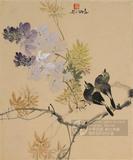董邦達柳浪聞鶯御題 軸
推薦分享
資源連結
連結到原始資料 (您即將開啟新視窗離開本站)後設資料
- 資料識別:
- 故畫002912N000000000
- 資料類型:
- 類型:繪畫
- 型式:靜態圖像
- 著作者:
- 董邦達
- 主題與關鍵字:
- 名勝 客舫 城牆 籬笆、圍牆 欄杆 池水 庭院 橋 百姓 楊柳 房舍 水榭
- 出版者:
- 數位化執行單位:國立故宮博物院
- 格式:
- 本幅 68.6x37.9公分、詩塘 38.2公分、下方 47.2x38.3公分、全幅 58公分
- 關聯:
- 故宮書畫錄(卷八),第四冊,頁134&*故宮書畫圖錄,第十二冊,頁1-2&*石渠寶笈三編(延春閣),第五冊,頁2317-2325&* 董邦達(西元一六九九-一七六九年),字孚存,浙江富陽人。雍正十一年(一七三三)進士,官至禮部尚書。畫山水法董其昌,得元人筆墨,以清麗勝。 本幅為西湖十景之一「柳浪橋」景。該橋在清波門、湧金門外,宋時即沿堤植柳,以此得名。畫中柳絲踠地,輕風搖颺,亭榭深深,如聞黃鶯啼於綠蔭中。筆調鬆秀蒼潤,表現出春湖景的謐靜感。 &*The Call of an Oriole at Swaying Willow Tung pang-ta (1699-1769) Ch’ing Dynasty Tung Pang-ta was a chin-shih degree holder and a high official at court. In painting, he followed the style of Tung Ch’i-ch’ang, achieving the manner of Yüan artists with clarity and elegance. This painting represents Swaying Willow Bridge, one of the ten scenic sites of West Lake at Hangchow. The bridge was located outside the Ch’ing-p’o and Yung-chin Gates of the city and noted for willows planted along the embankments in the Sung dynasty. Here, willow branches sweep the ground like strands of silk swaying gently in the breeze. Scattered deep among the trees are pavilions, from which one can almost hear the call of an oriole. The brushwork is rich and elegant, expressing the peaceful lake scenery in spring. &*宋代,豐豫門外沿堤植柳,地名柳洲,上有柳浪橋。堤上柳絲隨風搖颺,如翠浪翻空。春時,黃鶯哯睕其間,遊者傾聽,流連湖上。&*Warbling of Chinese Orioles Among Waving Willows Anonymous Inscription by Emperor Ch’ien-lung Ch’ing Dynasty During the Sung Dynasty (960-1275), willow trees were planted along the riverbank outside the Feng-yü Gate. When gentle winds blew through the willow branches, they looked like rolling green waves. The area became known as the “Willow Shore” and the bridge there was called the “Willow Wave Bridge.” In the spring, Chinese orioles warbled amons the willows, and visitors found it difficult to leave the Willow Shore. The Ch’ien-Lung Emperor (r. 1736-1796) was the fourth and most accomplished sovereign of the Ch’ing Dynasty.
- 管理權:
- 國立故宮博物院
授權聯絡窗口
- 國立故宮博物院圖像授權、出版授權、影音資料授權-申請流程說明
http://www.npm.gov.tw/zh-TW/Article.aspx?sNo=03003061






